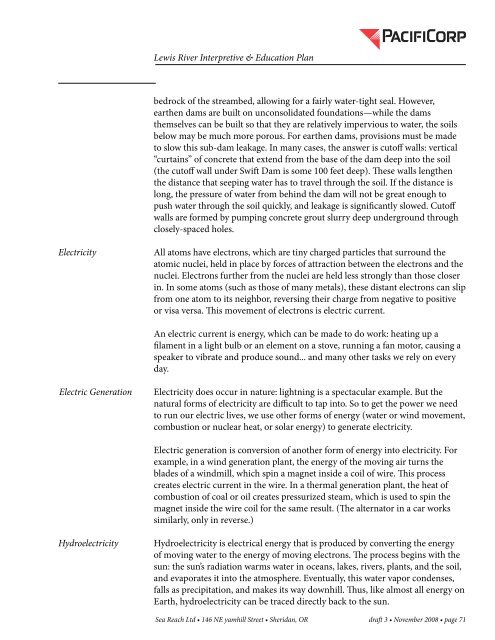The Lewis River Hydroelectric Projects - PacifiCorp
The Lewis River Hydroelectric Projects - PacifiCorp
The Lewis River Hydroelectric Projects - PacifiCorp
Create successful ePaper yourself
Turn your PDF publications into a flip-book with our unique Google optimized e-Paper software.
<strong>Lewis</strong> <strong>River</strong> Interpretive & Education Plan<br />
bedrock of the streambed, allowing for a fairly water-tight seal. However,<br />
earthen dams are built on unconsolidated foundations—while the dams<br />
themselves can be built so that they are relatively impervious to water, the soils<br />
below may be much more porous. For earthen dams, provisions must be made<br />
to slow this sub-dam leakage. In many cases, the answer is cutoff walls: vertical<br />
“curtains” of concrete that extend from the base of the dam deep into the soil<br />
(the cutoff wall under Swift Dam is some 100 feet deep). <strong>The</strong>se walls lengthen<br />
the distance that seeping water has to travel through the soil. If the distance is<br />
long, the pressure of water from behind the dam will not be great enough to<br />
push water through the soil quickly, and leakage is significantly slowed. Cutoff<br />
walls are formed by pumping concrete grout slurry deep underground through<br />
closely-spaced holes.<br />
Electricity<br />
All atoms have electrons, which are tiny charged particles that surround the<br />
atomic nuclei, held in place by forces of attraction between the electrons and the<br />
nuclei. Electrons further from the nuclei are held less strongly than those closer<br />
in. In some atoms (such as those of many metals), these distant electrons can slip<br />
from one atom to its neighbor, reversing their charge from negative to positive<br />
or visa versa. This movement of electrons is electric current.<br />
An electric current is energy, which can be made to do work: heating up a<br />
filament in a light bulb or an element on a stove, running a fan motor, causing a<br />
speaker to vibrate and produce sound... and many other tasks we rely on every<br />
day.<br />
Electric Generation<br />
Electricity does occur in nature: lightning is a spectacular example. But the<br />
natural forms of electricity are difficult to tap into. So to get the power we need<br />
to run our electric lives, we use other forms of energy (water or wind movement,<br />
combustion or nuclear heat, or solar energy) to generate electricity.<br />
Electric generation is conversion of another form of energy into electricity. For<br />
example, in a wind generation plant, the energy of the moving air turns the<br />
blades of a windmill, which spin a magnet inside a coil of wire. This process<br />
creates electric current in the wire. In a thermal generation plant, the heat of<br />
combustion of coal or oil creates pressurized steam, which is used to spin the<br />
magnet inside the wire coil for the same result. (<strong>The</strong> alternator in a car works<br />
similarly, only in reverse.)<br />
<strong>Hydroelectric</strong>ity<br />
<strong>Hydroelectric</strong>ity is electrical energy that is produced by converting the energy<br />
of moving water to the energy of moving electrons. <strong>The</strong> process begins with the<br />
sun: the sun’s radiation warms water in oceans, lakes, rivers, plants, and the soil,<br />
and evaporates it into the atmosphere. Eventually, this water vapor condenses,<br />
falls as precipitation, and makes its way downhill. Thus, like almost all energy on<br />
Earth, hydroelectricity can be traced directly back to the sun.<br />
Sea Reach Ltd • 146 NE yamhill Street • Sheridan, OR draft 3 • November 2008 • page 71
















